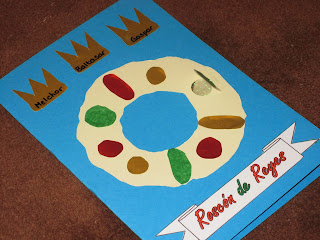I have a confession to make. This isn't my idea. Well, it started off as my idea, and had another idea added to it by a very clever student.
I always liked working with NQTs back in my secondary days, as they always brought with them lots of fresh ideas and new ways of doing things. I'm now a language tutor on the Primary PGCE course at Manchester University, and I am learning from the students there. My input on their first language day in September was ideas for promoting reading and writing in the languages classroom, and one of the things I showed them was how to make calligrams like
these. Their second session was language-specific, and the Spanish group talked about using the works of
Joan Miró to inspire lessons. Yesterday we went to a junior school in Stockport, where the students had the task of teaching a 30 minute language activity to a small group of Year 5 or Year 6 children.
For me, one of the students stood out from the rest. She presented the colours in Spanish to the children and then gave them a black-and-white Miró-style picture (that she had drawn herself) which they coloured in and labelled calligram-style.
Now I don't know much about Miró, as my artistic endeavours thus far have been limited to
Gaudí and
mosaics. So I did a bit of digging to see what it was all about, and have had a go at the calligramming myself. I created my Miró-esque picture using
this resource as a guide. Then I coloured it with coloured pencils, and used coloured fineliners to write the colours in:
I'm determined now to find out more about Miró's art and to incorporate this activity into the colours section of my
Key Stage 2 Spanish scheme of work. Ya-boo-sucks to the new curriculum and its lack of desire for culture.
Here are some of the Miró links that I've found so far:
Draw like Miró, collage style
Another way of making Miró-style artwork
TES Miró resources
Rachel Hawkes's Miró resources
Of course you could use other artists for the same idea:
Arcimboldo (and perhaps write the food names in instead of the colours)
Mondrian
Kandinsky (perhaps)
Klee
Van Gogh (in simplified form)
GaudíMatisse (also see
this blogpost)
So thank you to the very clever student for taking two ideas and making something so much better by putting them together.
UPDATE 18.11.13:
My Year 2 class have been working on 2D shapes and numbers to 15. We have been counting shapes in pictures and writing numbers, and have also used colours to help us. (The resources are here if you'd like to use them.) I've used the Miró idea and a box of 2D shapes to create pictures like these:
There is a space at the bottom of the A3 sheet, under the frame, for them to complete the sentence "En mi cuadro hay ____ círculos, ____ cuadrados y ____ triángulos."
Another great Miró link for you as well, again via the wonders of Twitter. This is another Miró dice roll activity, but for making Miró-style people.














